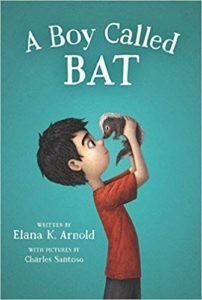Why I Picked It Up: We listen to a lot of audiobooks in the car as we drive around town. We had just finished a story and I found this one while I was quickly scrolling through the list of available titles to find our next one. The cover looked familiar – I’d seen it on the local Battle of the Books shelf at our library – but I hadn’t read it and didn’t know much about it at all, so we checked it out!
Why I Finished It: A Boy Called Bat completely captivated us! Bixby Alexander Tam (B.A.T. or just “Bat”) is a third-grader at Saw Whett Elementary. His appropriately nicknamed because he loves animals, flaps his hands when he’s nervous or excited, and is sensitive to loud noises. One day, His mom brings home a baby skunk and Bat falls in love. He devotes himself to the care and feeding of the skunk and would love to keep him as a pet. His mom says they can only keep it until it’s old enough to go to the wild animal rescue center in a month. Of course, being obsessed with the skunk, Bat doesn’t take no for an answer and tries to convince his mom that he is indeed capable of raising a pet skunk. We had to find out if he was successful!
When we started listening to, or “reading” this book, I had no idea that Bat had autism. Since I’d seen the cover lately, I didn’t take the time to read the description before we started it. Of course, as an educator, I started to suspect something as we learned more about Bat’s character and the story progressed, but my son (a kindergartner) had absolutely no clue anything was different about Bat. I loved this approach to reading the book because it did away with labels that create bias, even if not on purpose.
On the surface (i.e. to a kindergartener), A Boy Called Bat is a sweet, completely relatable story about a boy who loves an animal. As we know, however, even “normal” life as we know it is usually anything but simple. Arnold delves into a wide variety of relationships between Bat and the people in his life – his mom, dad, sister, teacher, school classmates. The situations Bat experiences are fairly common (with the major exception of caring for a baby skunk!), but as readers, we are able to see the added layer of complexity that autism adds to these “normal” situations in a very relatable and identifiable way.
Who I Would Give It To: Any elementary student will enjoy this as a fun read aloud. In fact, it was selected as a 2018 Global Read Aloud choice! A Boy Called Bat a must for students who interact with autistic classmates or family members to help bring broader perspective and understanding to those relationships.
Integration Ideas
Theme
Diversity
- Why do we choose to use labels in society?
- When are labels harmful? When are labels helpful?
“The word ‘autistic’ is never used here, and its absence is effective: Bat’s tendencies are treated as characteristic and not diagnostic, and Arnold seamlessly weaves in Bat’s and his family’s adaptations to his behaviors.” Bulletin for the Center of Children’s Books Review
As the teacher, you might read reviews or the blurb on the back of the book that says it stars an “unforgettable young boy on the autism spectrum.” But your students may or may not catch it. If at all possible, see if you can avoid discussing autism before they read the book. Have students go into it without preconceived notions. Some might notice that Bat has some different kinds of tendencies. Some might not. That’s a great start to a conversation! Once you’ve read the book, if none of the students has brought it up organically, then talk about autism. What is it? Why did Arnold choose not to use that label? Could you tell from the book that Bat has autism? Would it have made a difference if she had labeled him?
Relationships
- How are people transformed through their relationships with others?
- How do friendships change over time?
Both of these questions are very applicable in this story! See the Character Analysis section below for more details!
Importance of Names
In several instances in A Boy Called BAT, names play a significant role. Bat’s own name, for example, is his initials but seems to describe him rather perfectly. He does love animals, he flaps his hands when he’s excited, and he is sensitive to loud noises. His dad calls him “sport,” which Bat does not like (p 65-66). Talk about nicknames with your students. What (school-appropriate) nicknames do they have? How or why did they acquire those names? Do they still fit? Who calls you those names? What does that indicate about a relationship?
The naming of the skunk is a pretty meaningful event as well. Janie gets the credit for Thor (p 82-83), which is practically descriptive of the day on which he was born, but also (they hope!) prophetic as they want the baby skunk to grow big and strong. This could lead to discussions about the origins of names, and even to further activity as students interview family members to find out why they got their names and what they mean. Have students research their name using Wolfram Alpha, a computational knowledge engine, and websites like Behind the Name, which will provide information about the country of origin, meaning, related names, etc.
For a fun tech addition, have students create a word cloud (Word Art is one that we’ve used and loved!) in the shape of their name, including important words they’ve either found from their research or words that describe them.
Try this free name interview activity.
Research & Guest Speakers
Bat is determined to keep Thor, and so writes to a world skunk expert with the help of his teacher. Did you know a world skunk expert is a real thing?? Dr. Jerry Dragoo, to whom Bat writes in the book, is a real person with a real website about skunks that you can visit: http://dragoo.org/
Bat’s experience as he tries to build a case to keep the skunk is a great model for students as they develop interests. While the book doesn’t go into detail, based on insights Bat gives us into Mr. Grayson’s child-centered pedagogy and classroom management style, one can only assume that Mr. Grayson seized the opportunity presented by Bat’s curiosity to have a teaching moment about research and interviewing. Most kids are naturally curious about SOMETHING, so let them run with it!
Reaching out to live contacts regarding their topic of interest goes a long way to keep that interest sparked. When students see that there are relevant connections to the things they are interested in, they tend to be that much more invested in their work. Twitter is a great place to start to see if there is someone who might be able to connect you to someone in a particular field, country, profession, etc. Microsoft has a great list of guest speakers that are experts in different fields that are willing to Skype with your class.
Different Perspectives
A Boy Called BAT puts you in Bat’s shoes, to experience things from his perspective. Unless they have a family member or close friend who is autistic, most kids probably don’t understand what it means to be autistic, how that disability can affect people, and how they can relate to people who deal with autism on a daily basis. Throughout the story, the author does an excellent job of helping the reader feel what Bat feels. Here are a few key examples:
- Mom was late and didn’t get the vanilla yogurt – p 14
- Unspoken rules – p 56
- Not knowing what to say in social situations – p 96
- Overwhelmed with compounding events – p 168-169
Character Analysis – Relationships and Change
The book explores and showcases Bat’s relationships with the people in his life – his divorced parents, his sister, and his classmates. In one scene (p 123-124), Bat overhears Janie’s patience wearing thin as she has to deal with the unusual behavior of her brother. Chapter 19 illustrates family dynamics between brother and sister as Bat’s intended act of kindness isn’t received as intended. “Baby skunks are easier than sisters,” Bat points out (p 130). Chapter 22 shows a different kind of interaction between Bat and Janie, a non-verbal connection that helps him feel close to her without the pressures of communication.
Bat’s friendship with Israel, his classmate, is developed throughout the book. It starts off a bit rocky, as Bat fails to catch the social cues between Lucca and Israel in the lunch room (p 48-49). As the story goes on, readers may be able to recognize Israel’s efforts to be friendly, whereas Bat seems to be clueless. However, the two boys develop a bond over the baby skunk and, with the help of Bat’s mom, Bat starts to realize that he might actually have a friend. (p 63, 95-96, 142-143, 167-170, 174-175, 177, 188)
How have you used this text?










loved the boooooooooooooooooooooooooooooooooooooooooooooooooooooooooooooooooooooooooooooooooooooooooooooooooooooooooooooooooooooooooooooooooooooooooooooooooooooooooooooooooooooooooook
We did as well!